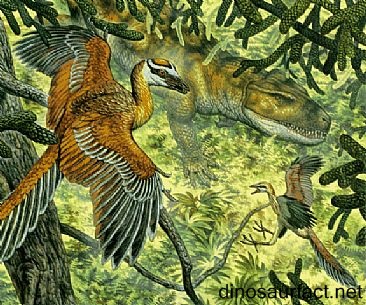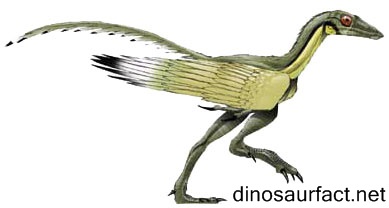 Click to visit the previous dinosaur bio
Click to visit the previous dinosaur bio
 |
|
 |
|
Kingdom: Animalia
Phylum: Chordata
Class: Sauropsida
Superorder: Dinosauria
Order: Theropoda
Family: Protoavidae
Genus: Protoavis
 |
|
 |
|
 |
|

The Protoavis, an extinct ancient dinosaur hails from what is now the country of the United States in the continent of North America. Belonging to the late Triassic period, it is believed to have lived on earth around 210 million years ago. A small carnivore, the creature is named the “first bird”, an implication that this creature could very well be the first of the living organisms that was capable of flight.
The late Triassic is the last of the three periods of the Triassic. The three stages of Carnian, Norian and Rhaetian together constitute the Upper or late Triassic period.
The discovery of the Protoavis fossils
The first Protoavis fossils were found in the southwestern part of the United States, near Post in the State of Texas. The fossils were found in the Dockum group. The discovery has been credited to Sankar Chatterjee who, along with his students, discovered the fossils in 1973. The fossils are weathered and crushed from serious weathering effects.
The holotype specimen is numbered TTU P 9200. Another fossil specimen, now the paratype TTU P 9201 has been discovered from the same formation as the holotype. These two are housed at the Texas Tech University.
The Dockum group and its Triassic Formations
The Dockum group lies in southwestern USA in Texas and New Mexico. The Dockum group consists of rocks from the Carnian to Norian stages. It is a geological formation of paleontological importance. The group includes formation like the Bull Canyon Formation, the Santa Rose Formation, the Trujillo and Cooper Canyon formations. Remains of the Protoavis were found in the Miller quarry of the Cooper Canyon Formation. The Dockum group and Chinle formations belong to the same era of the Mesozoic age.
Having been deposited in the same time period, these two formation groups have a lot in common, concerning both fossil data and ecological environment. Both of these sites has produced many important dinosaurs and archosaurs among other prehistoric Triassic creatures.
Sankar Chatterjee is a world renowned paleontologist. He has published many important papers about the prehistoric Mesozoic ages. He is also credited with the discovery and classification of a number of dinosaurs. He is the curator of paleontology at Texas Tech University’s Museum and also a professor there. He has focused primarily on avians including the Archaeopteryx and Tupandactylus, besides the Protoavis.
Physical features and Structure of the Protoavis
The protoavis has been regarded as one of the earliest avian creatures, even before than what is commonly believed as the ancestor of birds: the Archaeopteryx. This is because the fossils that have been hitherto found display some strong avian traits. These include the presence of a beak like mouth. Also there is the presence of the much debated and argued-over quill knobs, the attachment points of feathers onto bones.
Chatterjee claims that the structures displayed on the creature’s shoulder girdle are actually quill knobs. Even so, the femora of the creature is strictly terrestrial. The hand houses five digits, which is a hitherto unseen feature in birds or other aerial beings. The eyes are located at the anterior of the head.
The Protoavis is assumed to be a small, bipedal creature. It is believed to have measured up to about 35 centimeters. The estimated weight of the creature is around 2-3 kilos. If the bird theory is rendered invalid, paleontologists think that the Protoavis would in fact, belong to the theropod family or a ceratosaur.
About the Protoavis dinosaur
The Protoavis is one of the most controversial dinosaurs (if it is a dinosaur, at that). The biggest controversy of course is whether the Protoavis is in fact, a bird. While Chatterjee claims that the Protoavis has more in common with modern birds than the latter Archaeopteryx, there is no substantial proof to second that belief. However, the carnivorous nature of the creature, bird or not, has been confirmed and agreed with.
The main reason for this is the disarticulation of fossils and the eroded nature of the original fossils as well. Whatever claims there are to establish the Protoavis as the first avian creature, requires hard proof as this is an important speculation to make. If we agree that this creature is the alleged predecessor of modern day birds, we push the evolution of the flight of living creatures back into the Triassic, which is about 60- 70 million years before than what is now thought as the evolution of aerial creatures.
This would shake some rather strong beliefs about the Earth’s paleo biology and ecology. The evolution of winged creatures has been known to first occur in Europe and Asia in the Cretaceous period. Thus, the inclusion of Protoavis as a bird would raise some serious doubts as to the intervening time lapse between them.
While many side with Chatterjee and his claim that his fossil belongs to an avian, other skeptical paleontologists refute these claims with the simple explanation that the fossils are actually a juxtaposition of bones from various dinosaurs. This collection of fossils is known as ‘a chimera’. This implies, that not only does Protoavis not exist but that it could be a bunch of creatures like archosaurs and Ceratosaurus fossils of which were juxtaposed together to give rise to this new species. This would imply that the Protoavis is a ‘nomen nudum’.
Of all things, the most important thing to learn is the importance of the preservation of fossils. The preservation of fossils can prove to be more important than their discovery or analysis. Had the Protoavis fossils been carefully preserved, the mystery surrounding this creature would have been totally uncovered. However now the best we can do is speculate and argue about the creature’s existence.
Until further fossil data is discovered, the classification and identification of Protoavis will not be complete. For now, it is belief that matters; and belief has no place in the world of science, especially while dealing with the Earth’s ecological timeline. The Protoavis could be the turning point of evolution in dinosaurs, from reptiles to birds. Or it could just be nothing.
Index
Extinct Profiles
 Triassic Dinosaurs
Triassic Dinosaurs Jurassic Dinosaurs
Jurassic Dinosaurs Cretaceous Dinosaurs
Cretaceous Dinosaurs Pterosaurs
Pterosaurs Marine Reptiles
Marine Reptiles Dinosaur Extinction
Dinosaur Extinction